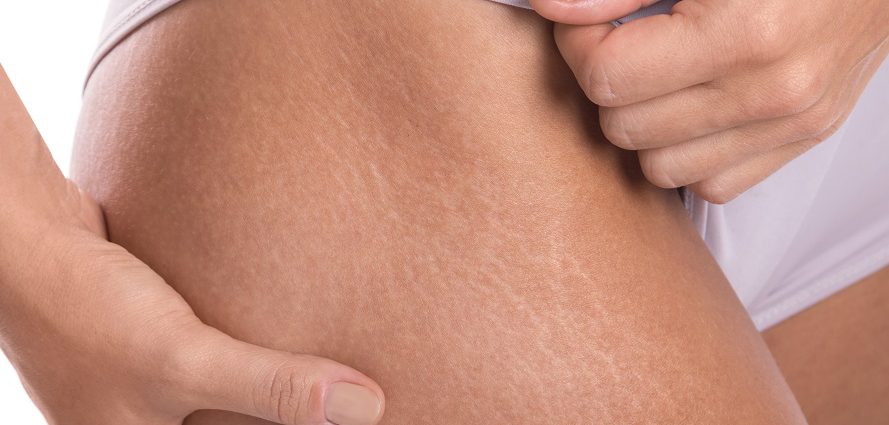What to Do When Stretch Marks the Spot

Stretch marks. The mere mention of these unsightly red or purple bands is enough to makes many of us cringe. If you don’t know what they are, consider yourself lucky (at least for now).
Also known as striae, stretch marks are basically scars left behind after the rapid stretching of skin. They may follow growth spurts, puberty, pregnancy or any other bout of significant weight gain. They can show up on your abdomen, breasts and thighs.
And once you get them, stretch marks are hard to get rid of.
Why Me?
Unfortunately, we are all at risk for developing stretch marks.
As New York City dermatologist Joshua Zeichner, MD, explains, “A lot has to do with genetics. If your mom and dad have stretch marks, you probably will get them too.”
When girls go through puberty, and their breasts start to develop, so too can stretch marks, he says. More than 90 percent of women will get them during the sixth and seventh months of their pregnancy. But, “they can occur during any period of rapid weight gain,” Zeichner says. Certain medical conditions, including Cushing’s syndrome, which results in an overproduction of the stress hormone cortisol, are risk factors for stretch marks. Individuals who take steroids to treat any illness for an extended period of time may also develop stretch marks.
There is, unfortunately, no fail-safe method that will prevent stretch marks. There are, however, things we can all do to help minimize the chances of developing them. This includes getting regular exercise and maintaining a healthy body weight.
Routine use of moisturizer may also help. “This keeps the skin barrier in as good of shape as possible by keeping skin well hydrated,” he says.
But what if you get them despite these efforts?
Stretch Mark Treatments: Do They Stretch the Truth?
The good news is that stretch marks often fade over time, and those that don’t fade can be treated with topical creams and lotions or, increasingly, some lasers. Stretch marks can also be camouflaged, according to Zeichner. “Self-tanners stain the skin and mask appearance of stretch marks,” he says.
“There is no ‘cure’ for stretch marks, but some treatments can lessen their appearance,” Zeichner adds.
Topical agents such as retinoids stimulate collagen and can help minimize the discoloration and depth of existing stretch marks. Collagen is the main protein found in skin, and is responsible for providing its structure. Examples include Retin-A.
Caution: These products can’t be used during pregnancy.
Some lotions and potions rely on peptides to help diminish stretch marks. Peptides are essentially building blocks of proteins such as collagen. Examples include Strivectin and Bio-Oil.
Another product, Mederma® Stretch Marks Therapy, relies on onion extracts to improve the look and feel of stretch marks. Do they work? It’s hard to say for sure, but they can be worth a try, Zeichner says.
Lasers also have a role in treating stretch marks. The key is choosing the right laser for your skin type and stretch mark.
If stretch marks are raised and red, pulsed dye laser therapy can help tone them down and soften their appearance. By contrast, the Fraxel or other fractional lasers can reduce white stretch marks, or those that have been on the body for a longer period of time. These lasers treat a mere fraction of the skin’s surface, and create a controlled wound healing environment, which may help stimulate the development of new collagen.
Don’t expect instant gratification, Zeichner cautions. Laser therapy involves three or more treatments spaced four to six weeks apart. “We are not promising a cure,” Zeichner says.
If you have stretch marks on your abdomen, a tummy tuck can get rid of them. However, as Zeichner explains, “You remove the skin, but you are really replacing one mark with another one.”
Costs vary based on which route you take to get rid of stretch marks.
Topical Lotions and Creams: These vary from $5 to $150 for a six-month supply.
Laser Scar Reduction: Cost varies widely, but can be about $1,500 for a series.
If the cost is too much for you to pay at once, ask your doctor about payment plans.
Final Word on Stretch Marks
Discuss your concerns with a board certified plastic surgeon or dermatologist. He or she will examine your skin and stretch marks, and tell you what is and is not realistically possible. Be sure to discuss family planning too. It may make sense to wait until you are finished having children to treat your stretch marks.


